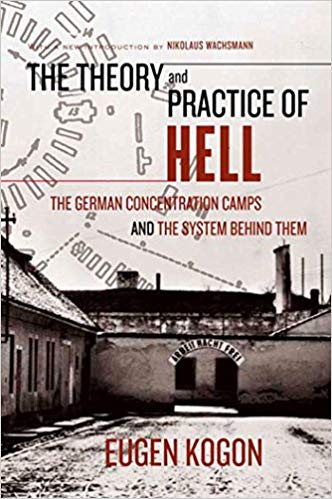Nazi Concentration Camps Low Survivorship Mischlinge Leniency Kogon

The Theory and Practice of Hell, by Eugen Kogon. 2006
Forget the Death Camps: Low Survivorship in Many “Ordinary” Nazi Concentration Camps. Jews Not Necessarily Treated Worse Than Poles
Eugen Kogon, the author or this book, was a left-wing German political prisoner at Buchenwald concentration camp. Throughout this book, he praises left-wing political groups. He even equates the Allied bombing of Hiroshima with the Nazi concentration camp system (p. 5). Nevertheless, he provides invaluable insights into this system. (My father had been an inmate at Gross Rosen and then Dachau). Many of Kogon’s descriptions are very graphic, and the sensitive reader would do best to avoid this book.
CAUSES OF LOW SURVIVORSHIP IN NAZI CONCENTRATION CAMPS
A common feature of the Nazi concentration camps was forced labor under appalling conditions. Kogon writes: “The stone carriers on these details—mainly Jews, Russians, and Poles—were often compelled to run the gauntlet, staggering under their heavy loads. The most notorious of the SS ‘punchers’ were always ready for such a ‘pastime’. Of 181 Poles who arrived at Buchenwald on October 15, 1939, more than half of them perished in this way within ten days.” (p. 89).
INCARCERATED JEWS WERE NOT CONSISTENTLY TREATED WORSE THAN INCARCERATED POLES
In some instances, the Poles were actually treated worse than the Jews! Kogon comments: “In 1938-1939, the Jews, chiefly those of Vienna, had been forced to sign over their houses and property to Nazis and their creatures. The ‘sales prices’ ranged down to ten marks! In the case of the Poles an even simpler procedure was adopted. They received no payment whatever. They were simply notified that they and their families had to leave their homes. To refuse to give the required signature was tantamount to suicide.” (p. 188).
Ironic to the later Nazi project of destroying the European Jews, the Nazis apparently did not do a systematic search for Jews in the concentration camps themselves. Kogon writes: “Many Jews, especially if they were not German, lived in the camps unrecognized—i. e., the SS never identified them as Jews.” (p. 185).
NAZI POLICIES TOWARDS THE MISCHLINGE GREW MORE LENIENT WITH TIME
Interestingly, the persecutions of those of partial Jewish descent was relaxed with time: “At a later day, ‘quarter Jews’ and ‘half-Jews’ were in part ‘aryanized’ and no longer wore the yellow triangle. For most of those affected it was already too late.” (p. 185). So it is not true that Nazism, as radical evil, consistently became more radical in its anti-Semitism as time went on.
EXTRANEOUS HORRORS
Horrific “scientific” experiments were performed on the prisoners. For example, new malarial vaccines were tried on Polish Catholic priests incarcerated at Dachau, and this caused serious losses among them (p. 151). In addition, “At the Dachau concentration camp in 1942 and 1943 abscesses were artificially induced, in order to test the efficacy of allopathic and homeopathic drugs. The subjects were chiefly Catholic clerics and Poles.” (p. 162).
Serious attempts were made the Nazis to perfect mass-sterilization methods, and numerous prisoners were subject to heinous experiments in this regard (pp. 157-161). This demonstrates that Nazi plans for genocide of large numbers of peoples besides Jews (e. g., the Slavs) had in fact gone well beyond the talking stage.
The homosexuals incarcerated in the Nazi concentration camps have been magnified by modern gay-rights groups into some sort of systematic Nazi persecution of homosexuals. In actuality, the number of homosexuals incarcerated was relatively small. Furthermore, there were usually extraneous reasons for even this incarceration. Kogon writes: “It included individuals of real value, in addition to large numbers of criminals and especially blackmailers. This made the position of the group as a whole very precarious. Hostility toward them may have been partly rooted in the fact that homosexuality was at one time widespread in Prussian military circles, as well as among the SA and SS, and was to be mercilessly outlawed and erased. The Gestapo readily had recourse to the charge of homosexuality, if it was unable to find any other pretext for proceeding against Catholic priests or irksome critics. The mere suspicion was sufficient.” (p. 37).
ENJOYING ONESELF, IN THE FACE OF HORROR, WAS NORMAL
Interestingly, the concentration camps included some semblance of normal living in the form of sports, theatre, musical bands, etc. (pp. 125-130). All this took place within sight of or within hours of someone being tortured and murdered. Engaging in such diversions was not, of course, a sign of disrespect for the dying and dead. This sheds light on comparable behaviors elsewhere. Holocaust films have shown Poles engaging in normal activities, such as Sunday worship, shopping, etc., and riding on a carousel, while the Jewish Ghetto was being burned by the Nazi Germans. This has been misrepresented as Polish callousness to Jewish suffering. It was no such thing. Comparable to the diversionary activities in concentration camps, it was an attempt to carry on a semblance of normal living under the conditions of German terror.
Polish scholar Ewa Kurek caught a lot of flak from the Jews by pointing out that the eventually-doomed Jews enjoyed themselves. This accusation was much ado about nothing.
To see a series of truncated reviews in a Category click on that Category:
- All reviews
- Anti-Christian Tendencies
- Anti-Polish Trends
- Censorship on Poles and Jews
- Communization of Poland
- Cultural Marxism
- German Guilt Dilution
- Holocaust Industry
- Interwar Polish-Jewish Relations
- Jewish Collaboration
- Jewish Economic Dominance
- Jews Antagonize Poland
- Jews Not Faultless
- Jews' Holocaust Dominates
- Jews' Holocaust Non-Special
- Nazi Crimes and Communist Crimes Were Equal
- Opinion-Forming Anti-Polonism
- Pogrom Mongering
- Poland in World War II
- Polish Jew-Rescue Ingratitude
- Polish Nationalism
- Polish Non-Complicity
- Polish-Ukrainian Relations
- Polokaust
- Premodern Poland
- Recent Polish-Jewish Relations
- The Decadent West
- The Jew as Other
- Understanding Nazi Germany
- Why Jews a "Problem"
- Zydokomuna